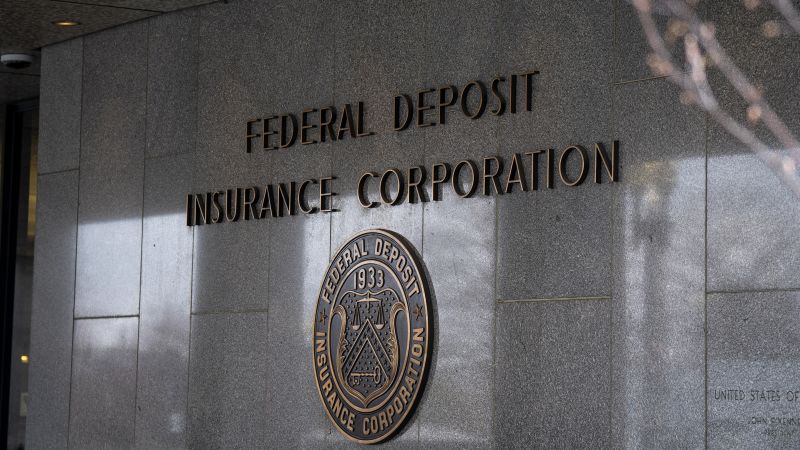A version of this story first appeared in CNN Business’ Before the Bell newsletter. Not a subscriber? You can sign up right here. You can listen to an audio version of the newsletter by clicking the same link.
It cost the Federal Deposit Insurance Corporation about $23 billion to clean up the mess that Silicon Valley Bank and Signature Bank left in the wake of their collapses earlier this month.
Now, as the dust clears and the US banking system steadies, the FDIC needs to figure out where to send its invoice. While regional and mid-sized banks are behind the recent turmoil, it appears that large banks may be footing the bill.
Ultimately, that means higher fees for bank customers and lower rates on their savings accounts.
What’s happening: The FDIC maintains a $128 billion deposit insurance fund to insure bank deposits and protect depositors. That fund is typically supplied by quarterly payments from insured banks in the United States. But when a big, expensive event happens — like the FDIC making uninsured customers whole at Silicon Valley Bank — the agency is able to assess a special charge on the banking industry to recover the cost.
The law also gives the FDIC the authority to decide which banks shoulder the brunt of that assessment fee. FDIC Chairman Martin Gruenberg said this week that he plans to make the details of the latest assessment public in May. He has also hinted that he would protect community banks from having to shell out too much money.
The fees that the FDIC assesses on banks tend to vary. Historically, they were fixed, but 2010’s Dodd-Frank act required that the agency needed to consider the size of a bank when setting rates. It also takes into consideration the “economic conditions, the effects on the industry, and such other factors as the FDIC deems appropriate and relevant,” according to Gruenberg.
On Tuesday and Wednesday, members of the Senate Banking Committee and the House Financial Services Committee grilled Gruenberg about his plans to charge banks for the damage done by SVB and others, and repeatedly implored him to leave small banks alone.
Gruenberg appeared receptive.
“Will you commit to using your authority…to establish separate risk-based assessment systems for large and small members of the Deposit Insurance Fund so that these well-managed banks don’t have to bail out Silicon Valley Bank?” asked the US Rep. Andy Barr, a Republican who represents Kentucky’s 6th district.
“I’m certainly willing to consider that,” replied Gruenberg.
“if smaller community banks in Texas will be left responsible for bailing out the failed banks in California and New York?” asked US Rep. Roger Williams, a Republican who represents Texas’ 25th district.
“Let me just say, without forecasting what our board is going to vote, we’re going to be keenly sensitive to the impact on community banks,” replied Gruenberg.
Representatives Frank Lucas, John Rose, Ayanna Pressley, Dan Meuser, Nikema Williams, Zach Nunn and Andy Ogles all asked similar questions and received similar responses. As did US Sens. Sherrod Brown and Cynthia Lummis.
“I don’t doubt he’s still fielding a lot of phone calls,” from politicians pressuring him to place the burden on large banks, former FDIC chairman Bill Isaac told CNN.
Smaller banks are saying that they’re unable to pick up this tab and didn’t have anything to do with the failure of “these two wild and crazy banks,” said Isaac. “They’re arguing to put the assessment on larger banks and as I understand it, the FDIC is thinking seriously about it,” he added.
A spokesperson from the FDIC told CNN that the agency “will issue in May 2023 a proposed rulemaking for the special assessment for public comment.” In regard to Gruenberg’s testimony they added that “when the boss says something, we defer to the boss.”
Big banks: “We need to think hard about liquidity risk and concentrations of uninsured deposits and how that’s evaluated in terms of deposit insurance assessments,” said Gruenberg to the Senate Banking Committee, indicating that smaller banks that are operating carefully could be asked to bear less of the assessment.
A larger assessment on big banks would add to what will already be a multi-billion dollar payment from the nation’s largest banks like JPMorgan Chase
(JPM), Citigroup
(C), Bank of America
(BAC) and Wells Fargo
(WFC).
The argument is that the largest US banks will be able to shoulder extra payments without collapsing under it. Those large banks also benefited greatly from the collapse of SVB and Signature Bank as wary customers sought safety by moving billions of dollars worth of money to big banks.
Passing it on: Regardless of who’s charged, the fees will eventually get passed on to bank customers in the end, said Isaac. “It’s going to be passed on to all customers. I have no doubts that banks will make up for these extra costs in their pricing — higher fees for services, higher prices for loans and less compensation for deposits.”
It’s hard out there for a Wall Street banker. Or harder than it was.
The average annual Wall Street bonus fell to $176,700 last year, a 26% drop from the previous year’s average of $240,400, according to estimates released Thursday by New York State Comptroller Thomas DiNapoli.
While that’s a big decrease, the 2022 bonus figure is still more than twice the median annual income for US households, reports CNN’s Jeanne Sahadi.
All in, Wall Street firms had a $33.7 billion bonus pool for 2022, which is 21% smaller than the previous year’s record of $42.7 billion — and the largest drop since the Great Recession.
For New York City and New York State coffers, bonus season means a welcome infusion of revenue, since employees in the securities industry make up 5% of private sector employees in NYC and their pay accounts for 22% of the city’s private sector wages. In 2021, Wall Street was estimated to be responsible for 16% of all economic activity in the city.
DiNapoli’s office projects the lower bonuses will bring in $457 million less in state income tax revenue and $208 million less for the city compared to the year before.
Beleaguered retailer Bed Bath & Beyond will attempt to $300 million of its stock to repay creditors and fund its business as it struggles to avoid bankruptcy, reports CNN’s Nathaniel Meyersohn.
If it’s not able to raise sufficient money from the offering, the home furnishings giant said Thursday it expects to “likely file for bankruptcy.”
Bed Bath & Beyond was able to initially avoid bankruptcy in February by completing a complex stock offering that gave it both an immediate injection of cash and a pledge for more funding in the future to pay down its debt. That offering was backed by private equity group Hudson Bay Capital.
But on Thursday, Bed Bath & Beyond said it was terminating the deal with Hudson Bay Capital for future funding and is turning to the public market.
Shares of Bed Bath & Beyond dropped more than 26% Thursday. The stock was trading around 60 cents a share.
Read the full article here










